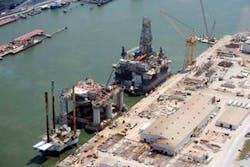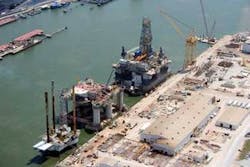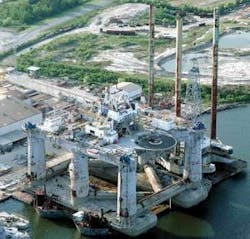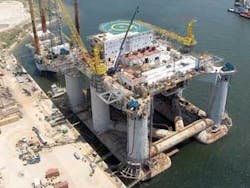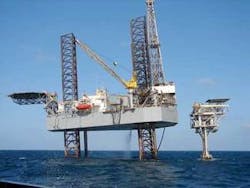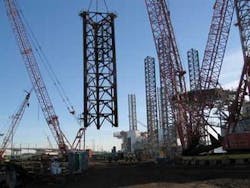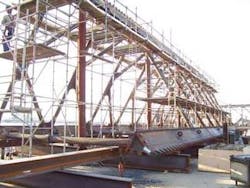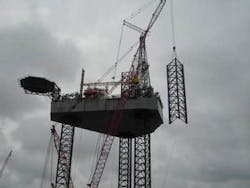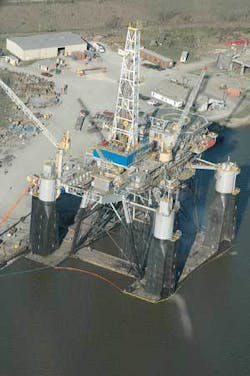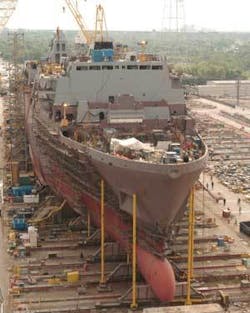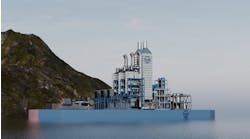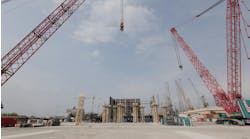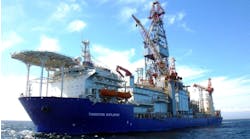David Paganie, Senior Editor
Signal International emerged on the scene in February 2003, lead by Dick Marler, president and CEO. The company was established through the acquisition of six marine and fabrication yards; four are located in the Port Arthur/Orange, Texas area and two in Pascagoula, Mississippi.
Signal’s East Bank Facility in Pascagoula, Mississippi has been host to a wide variety of drilling and production rigs during the current GoM boom. The rigs range in size from small jackups to large deepwater semisubmersibles. Photo courtesy of Signal International.
Signal maintains a diverse business strategy that it formulated at its inception with a principal focus on offshore drilling rig overhaul, repair, upgrade, conversion, and new construction, including heavy fabrication for the marine market.
Vision
Marler’s strategy was clear from the beginning. He wanted to build a company with a solid foundation that could compete in the Gulf of Mexico. And he feels that through patience, persistence, and vision, this stage in the company’s evolution has been reached.
Marler’s first task was to gain a presence in the GoM through the purchase of yards with capacity to handle a wide range of activities.
“We knew that once we acquired the needed resources we would be well on our way to gaining a significant market share in the repair, modernization and new construction of offshore drilling rigs, along with heavy marine fabrication and shipbuilding support,” says Marler.
“During our start-up, we were also able to select outstanding management and craft talent who understood the strategic advantage of executing a diversification plan,” he adds.
The company was established when the market was down, which could be considered a negative factor. However, Marler doesn’t see it that way. He views the timing of the company’s launch as fortunate.
“One very important factor about the foundation of this company is that we were established while the market was still down, which allowed us to get organized, step out and get our ISO 9001:2000 Certification, put in an improved safety program, and get our processes in place. Then when the market turned and we began winning contracts and building up our workforce, it was clear that we really had planted the seeds for growth.”
Capabilities
Signal’s capabilities can be characterized by its diverse portfolio of work. The company is busy on everything from module fabrication and delivery of sub-assemblies for ships, to rig refurbishments and conversions, newbuild floating production systems and rigs, and offshore on-location specific activities.
Marler attributes the company’s robust workload in part to pure economic fundamentals. “As the overall market for drilling rigs has improved, so have modernization and upgrade requirements, driven by oil companies.”
Marler adds that company’s comprehensive mix of resources clearly gives it an edge over its competition in the GoM.
“There isn’t another company that does what we do in the GoM that is as capable with the assets we have,” he says.
Signal’s six yards are positioned on the east and west end of the Gulf Coast in Mississippi and Texas.
Two of the company’s major contract awards in 2005 signify its ability to perform high-end conversion work.
In 2Q05, the company signed a $35.5-million contract with ETESCO Millennium Partners, LLC to convert a semisubmersible drilling rig into a 272-bed accommodation, construction, and repair platform. The semi is expected to be delivered from the yard in mid-2006. Then it will mobilize to Brazil to undertake a four-year commitment with Petrobras.
ETESCO’s semisubmersibleMillennium was converted into a 272-person accommodation, construction and repair facility. Pictured is the semi near completion at Signal’s Pascagoula West Yard. Photo courtesy of Signal International.
Recently, Signal completed a major conversion project for ATP Oil & Gas. The company used its Texas facilities to convert theRowan Midland mobile offshore drilling unit (MODU) into the Gomez floating production facility.
Conversion work included removal of the MODU’s derrick and associated drilling equipment, followed by installation of production modules and processing equipment. The unit’s five-month stint (includes time lost from the hurricanes) at Signal included four months in drydock with over 100,000 man-hours logged.
The floating production semi is installed on the ATP-operated Gomez field in 3,000 ft of water in Mississippi Canyon block 711.
Hurricane repair; preparation
Signal’s yards continue to work on rigs that were damaged offshore by hurricanes Katrina and Rita. A number of rigs have been repaired at the yard since the hurricanes, including Hercules Offshore’s mat-supported jackup,Rig 21, which required major steel replacement along with some upgrades. The rig was docked at the yard for five months.
Meanwhile, the company’s West Yard in Pascagoula is salvaging 100-ft of steel from each leg of the HerculesRig 25. The rest of the Katrina-damaged rig will be scrapped.
Also at the West Yard, the company undertook the unconventional task of salvaging a hurricane-damaged rig. Signal’s primary task was to repair the legs of GlobalSantaFe’s (GSF) 270-ft jackup,High Island II that were damaged by Hurricane Rita.
TheGSF High Island II was damaged while on location offshore during Hurricane Rita and suffered extensive damage to all three legs. The rig listed approximately 3.5 degrees towards the starboard and down approximately 6 ft on the bow leg. Photo courtesy of Signal International.
The company sent a crew offshore to survey the rig’s damage while it was still listing 3-5 degrees. All three legs of the jackup were found severely bent and twisted by the storm’s forces. Signal then towed the rig to its yard for repair.
First, 266-ft of steel weighing 250 tons from each of the 394-ft legs was removed to get to the damaged sections. The company says that in most cases, the damaged legs would have been scrapped and new ones would be fitted. But through the collaborative efforts of Signal, LeTourneau, and GSF, the legs were saved in their entirety.
The distorted sections were then straightened onshore, reassembled, and reinstalled; a move that saved the customer millions, according to Signal.
null
The repaired leg sections are being reinstalled onto the rig. Photo courtesy of Signal International.
Meanwhile, the company has been selected by some of the major drilling contractors to prepare their GoM-based fleets of MODUs for the upcoming hurricane season. Diamond Offshore has elected to upgrade its entire fleet of semisubmersibles to a 12-point mooring system. The contractor selected Signal to deploy a number of its employees offshore to perform the required work. According to Marler, the company typically maintains around 50-60 workers offshore.
Pictured is theNoble Joe Alford submersible at Signal’s North Yard in Port Arthur, Texas. Photo courtesy of Signal International.
Signal is upgrading theNoble Clyde Boudreaux semisubmersible for hurricane preparation as well. The rig is docked at the Pascagoula East Yard for outfitting with a 16-point mooring system comprising an eight-point traction winch and a windlass wire-chain arrangement coupled with an eight-point traction winch pre-set wire system. The rig is scheduled to be delivered in 2007.
New construction
Signal is undertaking construction of its first newbuild rig since its inception in early 2003. The company held a keel laying ceremony on May 11, 2006 to kick off construction of the 300-ft water depth rated jackup,Tarzan IV, for Rowan. The 225-C class rig will be capable of drilling to a total depth of 35,000 ft. LeTourneau is procuring the rig, while Signal handles construction at its Orange yard.
Signal intends to capture similar newbuild contracts in the near future, which falls in line with the company’s core strategy. “Construction of theTarzan IV jackup is really a milestone for us,” says Marler. “We expect to secure more orders to build this type of rig.”
Marler says Signal’s current capacity for newbuild work largely depends on the type of job. He points out that its facilities could ramp up and deliver three to four jackups a year or one semisubmersible per year.
However, Signal does not intend to devote all of its assets only to new construction. The company plans to maintain its diversity.
Signal is also undertaking construction of a new floating production unit. In mid-2005, Signal was selected by Atlantia Offsore to build the hull for the BHP Billiton-operatedNeptune TLP. Fabrication is underway at the company’s Orange yard.
The SeaStar-designed TLP will be capable of processing 50,000 b/d of oil, 50 MMcf/d of natural gas, and 30,000 b/d of water. The facility is scheduled to be delivered in 2007 for installation in 4,300 ft of water on the Neptune field in the Atwater Valley area.
Signal says it expects to win additional newbuild floating production contracts in the near future.
Diversification strategy
A good mix of assets and capabilities is the key to Signal’s long-term success, explains Marler. The company is directly involved with offshore drilling and production, but also provides services to the shipbuilding industry.
“We’ve been able to diversify our business approach primarily through our relationship with Northrop Grumman,” says Marler. The company is currently operating as a sub-contractor to Mississippi-based Northrop Grumman Ship Systems for the US Navy’s LPD-17 class shipbuilding program. Under its committed workscope, Signal is supplying sub-assemblies and modules from its Orange yard.
The USS Green Bay (LPD-20) is under construction at Northrop Grumman Ship Systems (NGSS) in Avondale, Louisiana. NGSS says Signal has been instrumental in building various units for the LPD-17 program, specifically for the LPD-20. The ship is expected to be commissioned in late 2006.
Photo courtesy of Northrop Grumman Ship Systems.
“Our strategy going forward is to continue growth into new construction of jackups and semisubmersibles, which will be performed at our Orange yard, along with shipbuilding component support.”
Marler characterizes the company’s Mississippi operation’s role as the premier provider of overhaul, repair, modernization, conversion, and upgrading of rigs. “Our experience here is really unmatched by any of our GoM competitors.”
In addition, the company says it does not have any immediate plans to add capacity in the US, but it has been considering the possibility of expanding its business overseas.
“It would be advantageous to have some resources overseas, particularly in the Middle East. Many of our customers are winning drilling contracts in this region and in Africa, thus driving demand for experienced support. We are still exploring how to best serve this market.”
Competence
Signal takes its safety record and providing a safe working environment for its employees very seriously. Marler says the company’s safety record gives it an edge in the market-place. Signal has successfully reduced its accident frequency over time, thereby laying the foundation for industry recognition. For example, the company’s Mississippi operation has been recognized for excellence in safety by the Shipbuilders Council of America (SCA) for the last three years.
Each year the SCA issues an excellence in safety award to the organization with the lowest total recordable OSHA incident rate for a given year. Signal’s Mississippi operation’s total recordable OSHA incident rate for 2005 was 0.66, compared to the SCA’s reported industry average of 8.74.
Additionally, Signal’s Mississippi operation’s incident rate of 0.50 through April 23, 2006 was considerably lower than the average for the shipbuilding industry of 12.9, according to 2004 data from the Bureau of Labor Statistics.
Another Signal distinction is its ISO certification. In early 2003, all of the company’s facilities in Texas and Mississippi earned a Certificate of Registration to ISO-9001:2000 for the construction, repair, overhaul, and conversion of MODUs, ships and other vessels and products used in the offshore and onshore markets.
According to Marler, this particular ISO certification is a process to ensure that a quality product is delivered. It also saves money for the customer because it provides a strict auditing system to help reduce the overall project cycle, he adds.
Part of the company’s ISO certified quality management system calls for a periodic measurement of welding performance. Its latest random test included inspection of almost 2 mi of welding, which resulted in a reject rate of .02%. According to Signal, this is an important achievement in reducing cost and maintaining customer confidence in its quality program.
Marler feels he has positioned Signal International with a competitive advantage in the Gulf of Mexico through its established business strategy, in-place core competences, and diversification philosophy.i
